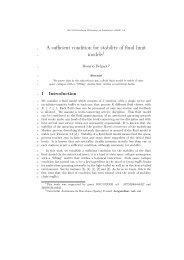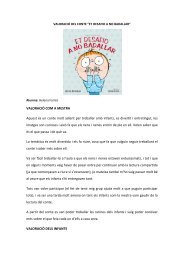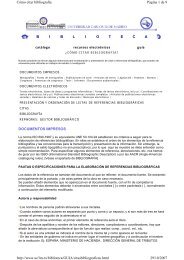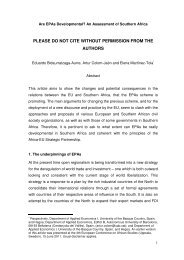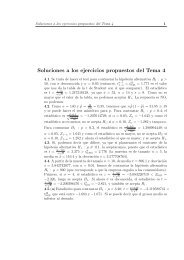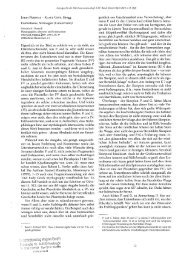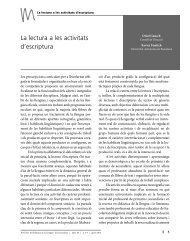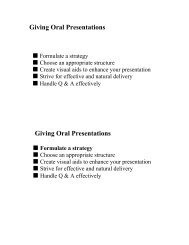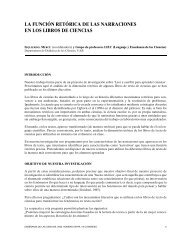J. Theor. Biol. 2006 - PÃ gines de la UAB
J. Theor. Biol. 2006 - PÃ gines de la UAB
J. Theor. Biol. 2006 - PÃ gines de la UAB
- No tags were found...
Create successful ePaper yourself
Turn your PDF publications into a flip-book with our unique Google optimized e-Paper software.
250<br />
ARTICLE IN PRESS<br />
J.F. Fontanari et al. / Journal of <strong>Theor</strong>etical <strong>Biol</strong>ogy 239 (<strong>2006</strong>) 247–256<br />
in Eq. (2). For example, in an extreme situation, in which<br />
only one vesicle passes the extinction stage, this sole vesicle<br />
will replenish the entire popu<strong>la</strong>tion (infinite or finite) in a<br />
single time step. In any event, provi<strong>de</strong>d that g does not<br />
equal 1, we can safely ignore this difficulty.<br />
2.3. Replication<br />
This process <strong>de</strong>scribes the replication of the temp<strong>la</strong>tes<br />
insi<strong>de</strong> the vesicles. As usual, we assume that the number of<br />
offspring that a temp<strong>la</strong>te contributes to the new generation<br />
is proportional to its re<strong>la</strong>tive replication rate. Since only N<br />
offspring are chosen to rep<strong>la</strong>ce the N parents we can write<br />
the probability that a vesicle of type ~ k changes to a vesicle<br />
of type ~j as<br />
Rð~jj kÞ¼ ~ N!<br />
j 0 !j 1 !...j d ! wj 0<br />
0<br />
w j 1<br />
1<br />
...w j d<br />
d<br />
, (3)<br />
where w l ¼ k l s l =w for l ¼ 0; 1; ...; d are the re<strong>la</strong>tive<br />
replication rates of the temp<strong>la</strong>te types. Here, w ¼ k 0 s 0 þ<br />
k 1 s 1 þþk d s d is the average replication rate of the entire<br />
popu<strong>la</strong>tion.<br />
2.3.1. Mutation<br />
The effect of the mutation process is solely to increase<br />
the number of temp<strong>la</strong>tes in the error tail. Hence, the<br />
probability that a vesicle of type ~j changes to one of type ~i<br />
is simply<br />
Mð~ij~jÞ ¼ j !<br />
1<br />
u j 1 i 1<br />
ð1 uÞ i 1<br />
...<br />
i 1<br />
!<br />
j d<br />
u j d i d<br />
ð1 uÞ i d<br />
(4)<br />
i d<br />
with j l 4i l for l ¼ 1; ...; d and j 0 pi 0 .<br />
The processes of temp<strong>la</strong>te replication and mutation can<br />
be <strong>de</strong>scribed by a single transition matrix Tð~ij kÞ¼<br />
P<br />
~ ~j Mð ~ij~jÞRð~jj kÞ, ~ that gives the probability that a vesicle of<br />
type k ~ changes to a vesicle of type ~i, due to replication<br />
immediately followed by mutation of the offspring. In fact,<br />
the present approach is feasible only because we can carry<br />
out the sum over the intermediate states ~j and <strong>de</strong>rive a<br />
closed expression for this combined transition matrix. We<br />
find<br />
Tð~ij kÞ¼ ~ N!<br />
i 0 !i 1 !...i d ! ½u þ w 0ð1 uÞŠ i 0<br />
½w 1 ð1 uÞŠ i 1<br />
...½w d ð1 uÞŠ i d<br />
; ð5Þ<br />
where w l are the re<strong>la</strong>tive replication rates given before.<br />
Finally, given the events comprising the life cycle of the<br />
temp<strong>la</strong>tes and vesicles we can immediately write down a set<br />
of coupled recursion equations for the frequencies of the<br />
different types of vesicles in the popu<strong>la</strong>tion:<br />
P<br />
Y tþ1 ð~iÞ ¼<br />
~k Tð ~ij kÞað ~ kÞY ~ t ð kÞ ~<br />
P<br />
~k að~ kÞY t ð kÞ ~ . (6)<br />
The main difficulty to iterate numerically these equations is<br />
that one has to keep track of the or<strong>de</strong>r of N d frequencies at<br />
each generation, thus setting limits to the vesicle capacity N<br />
and the temp<strong>la</strong>te diversity d we can investigate. All results<br />
presented in this paper are obtained in the stationary<br />
regime Y tþ1 ¼ Y t ¼ Y. We found these steady states<br />
remarkably insensitive to the choice of the initial distribution<br />
of temp<strong>la</strong>tes in the vesicles Y t¼0 ð kÞ: ~ provi<strong>de</strong>d that<br />
there are vesicles that contain all uncorrupted temp<strong>la</strong>te<br />
types, the dynamics will always approach the same steady<br />
state. In what follows, we will focus mainly on the fraction<br />
O m of vesicles that carry copies of mpd uncorrupted<br />
temp<strong>la</strong>te types, regardless of their redundancy.<br />
3. Coexistence of error-free temp<strong>la</strong>tes<br />
Before consi<strong>de</strong>ring the effect of imperfect replication and<br />
the consequent appearance of the error tail, in this section<br />
we focus on the somewhat simpler though fundamental<br />
problem of the coexistence of temp<strong>la</strong>tes with distinct<br />
replication rates. By setting u ¼ 0 and Y t¼0 ð ~ kÞ¼0, if<br />
k 0 a0, our mathematical formalism can be readily used to<br />
study this problem as well. As already pointed out, random<br />
drift will bar the coexistence of two or more distinct<br />
temp<strong>la</strong>tes in a vesicle of finite capacity. On the other si<strong>de</strong>,<br />
competition between temp<strong>la</strong>tes will lead to the dominance<br />
of the temp<strong>la</strong>te with the highest replication rate in the case<br />
of very <strong>la</strong>rge vesicles. Here, we address the issue of how<br />
strong the group selection pressure must be in or<strong>de</strong>r to<br />
counterba<strong>la</strong>nce the effects of drift and competition.<br />
Fig. 1, which disp<strong>la</strong>ys the fraction O 2 as a function of the<br />
group selection intensity g for d ¼ 2, N ¼ 50 and several<br />
values of the ratio s 2 =s 1 , reveals the existence of a threshold<br />
value for g, below which random drift and temp<strong>la</strong>te<br />
competition are the dominant forces, resulting then in the<br />
complete frustration of temp<strong>la</strong>te coexistence. To gauge and<br />
even disentangle the contributions of drift and competition<br />
we can vary the vesicle capacity N. This is illustrated in<br />
Ω 2<br />
1<br />
0.8<br />
0.6<br />
0.4<br />
0.2<br />
1.0<br />
0.75<br />
0<br />
0 0.2 0.4 0.6 0.8 1<br />
g<br />
0.5<br />
0.25<br />
Fig. 1. Fraction of vesicles with the two different types of temp<strong>la</strong>tes in<br />
their composition O 2 as a function of the group selection pressure g for<br />
N ¼ 50, s 2 =s 1 ¼ 1:0; 0:75; 0:5 and 0.25 in the case of error-free replication<br />
u ¼ 0.




